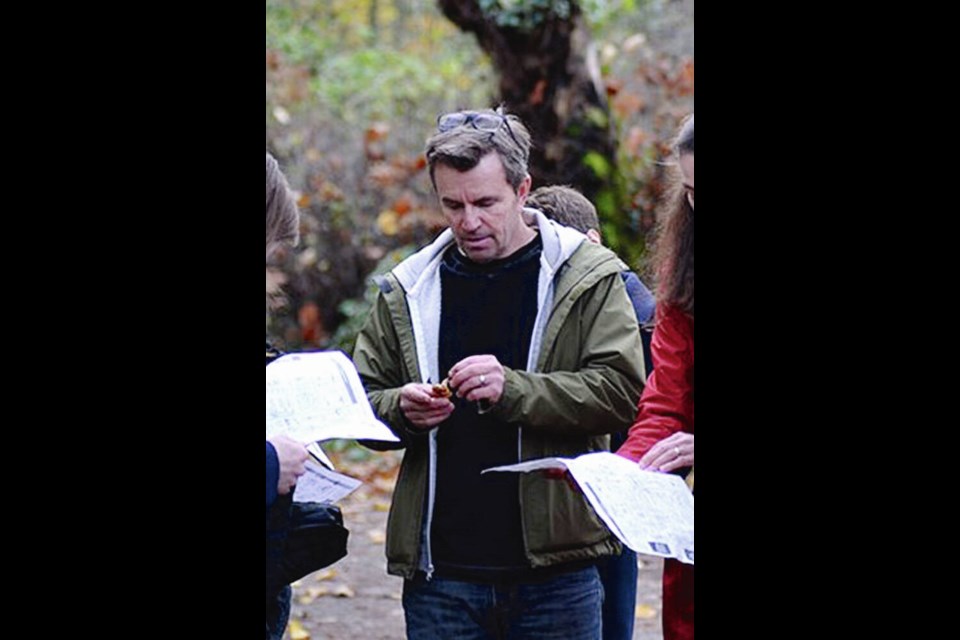Immortality for John (Marty) Kranabetter has come in the form of a mushroom.
The fungal ecologist from Saanich discovered a previously unknown mushroom species in a mature mixed forest near Smithers in 2009.
The pale grey, medium-sized basidiomata, with stout stem and rounded-gilled cap, is now officially known as Cortinarius kranabetteri — but to friends and family and fellow mycologists, it’s just “Marty’s mushroom.”
“I was pretty blown away,” said Kranabetter, 57, a scientist for province’s Ministry of Forests. “My colleagues and I have joked over the years about having a mushroom named after us. The people who wrote the final paper never even gave the head’s up, so it’s a surprise and an honour.”
Scientists at the University of British Columbia’s Beaty Biodiversity Lab studied Kranabetter’s mushroom at the molecular level, sequencing its DNA and comparing the results with global data bases. Taxonomists determined it was indeed one of a kind, and gave it its official Latin moniker.
The specimens remain in UBC’s vast mushroom vault.
Kranabetter collected two samples of the mushroom in the Smithers region while doing soil diversity studies for the province in boreal forest also containing spruce and pine. The mushroom was a symbiotic species, meaning it lives off the roots of trees.
There was another sample taken by a mycologist southwest of Hinton, Alta., in 2011, but the mushroom’s complete range and just how prolific its numbers might be isn’t clear.
Kranabetter hasn’t seen the species since.
“When I first started looking at mushrooms, collecting them and trying to put names to them was by using books, mostly from Europe, to find out what you could,” said Kranabetter. “Now we can send samples to UBC to determine the barcode of life, or the genetic nature of the species.”
British Columbia is awash in fungi. A 2017 survey of mushroom species noted more than 3,200 species across the province’s 94.5 million hectares — more than any other province. Many haven’t even been identified. There are many more only visible through a microscope.
The 350 entries in a field guide released this summer by the Royal B.C. Museum and authors Andy MacKinnon and Kem Luther represented only about 10% of the observed species, although about 800 are mentioned in the guide as comparisons in the notes.
Kranabetter is the third Victorian and fourth person in British Columbia to have mushrooms named in their honour. Oluna and Adolf Ceska, who have documented more than 1,400 mushroom species around Observatory Hill in Saanich over the past two decades, have two with their names — Cortinarius ceskae and Inocybe ceskae.
The other is Vancouver’s Paul Kroeger, best known for tracking the notorious death cap mushroom’s spread in urban areas. He collected a mushroom on Haida Gwaii years ago that now is called Cortinarius kroegeri.
That fungal diversity makes mushroom hunting an adventure, said Kranabetter, who leads public workshops and outings.
He noted recent research around the Capital Regional District’s Sooke Lake Reservoir revealed 200 species of mushrooms.
Many more new species are sure to be discovered.
“This shows the diverse species we have in our forests in British Columbia,” said Kranabetter. “We know all the plants and birds and animals, but with fungi we’re only 10% there. It’s fun to be in this job right now to make new discoveries.”
Kranabetter specializes in soil ecology and forest nutrition and productivity. He has published a number of papers on ectomycorrhiza fungal ecology and is a member of the provincial Future Forests committee examining vulnerability to climate change.
He has also been involved with regional efforts to manage pine mushroom and golden chanterelle habitat, and teaches workshops on mushroom identification.
MacKinnon, co-author of Mushrooms of British Columbia and a leading authority on fungi, said Kranabetter’s work in mycology has been invaluable in the field for both professionals and amateurs.
“This is a great honour, and essentially makes Marty immortal,” said MacKinnon. “Things named after people 200 years ago still bear those names. And it couldn’t have happened to a nicer guy.”
Kranabetter is taking it all in stride.
The father of two said as he was explaining the mushroom to his family, the first thing his mother-in-law asked was: “Can you eat it?”
He replied that you probably could, “but it wouldn’t taste too good.”
Right now, Kranabetter will just savour that feeling of immortality.


